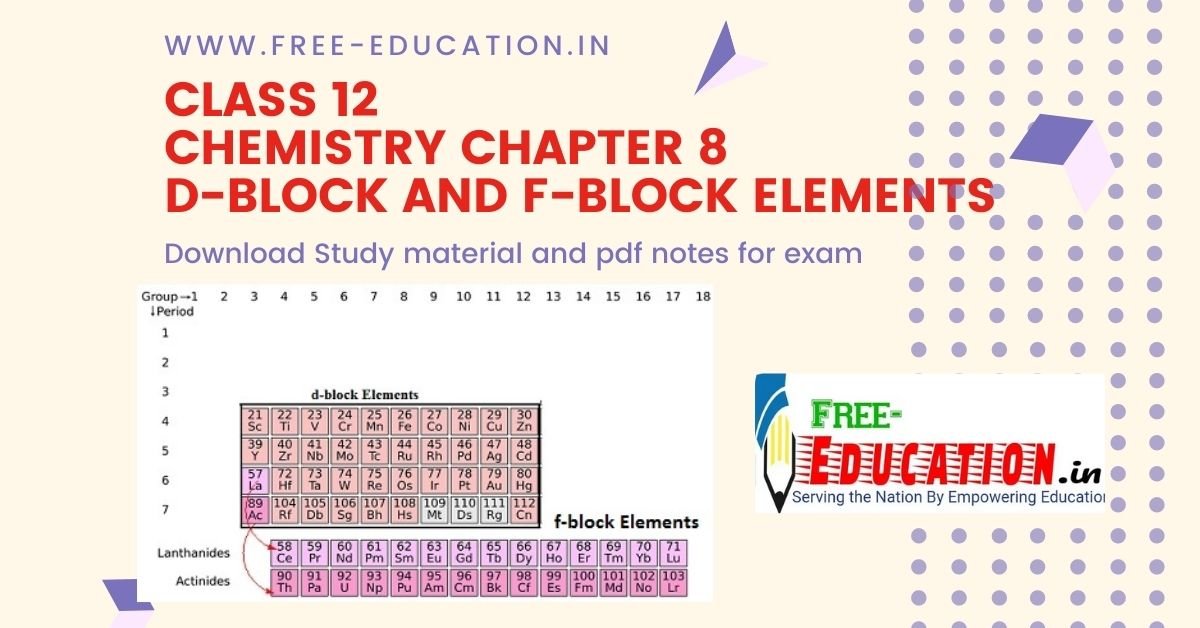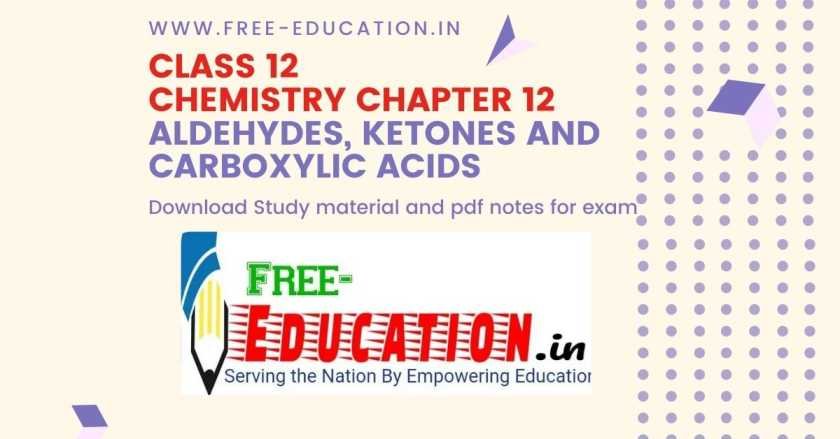www.free-education.in is a platform where you can get pdf notes from 6th to 12th class notes, General Knowledge post, Engineering post, Career Guidelines , English Speaking Trick , How to crack interview and lots more. ( d-and f-Block Elements )
Chemistry D and F Block Elements Notes
Introduction to d-block elements
- In the periodic table the d block consist of the elements of group 3 to 12.
- The d orbital of the d-block elements in four periods are filled.
- The three series of the transition metals are 3d series from Sc to Zn, 4d series from Y to Cd and 5d series from La to Hg.
- The fourth 6d series begins from Ac and is incomplete till now.
Position of d-block in periodic table
- The d-block elements are found in the middle section of s- and p- block elements in the periodic elements.
- This lead to its name ‘transition’ due to its position between s- and p- block elements.
Electronic Configurations of the d-Block Elements
- The electronic configuration of d-block elements is(n-1) d1–10 ns1–2. They have two incomplete outershells.
- Where (n–1) = Inner d orbitals having electrons from 1-10.
- ns = Outermost orbital may have one or two
- (n-1) d10 n s2 represents the electronic configurations of Zn, Cd and Hg.
- They exhibit variable valency that differ by units of one.
Physical Properties
- The transition metals are hard and tough. They have low volatility butZn, Cd and Hg are an exception.
- They have high melting and boilingpoints due to the greaterquantity of electrons from (n-1) d along with the ns electrons metallic
Fig. The trends in melting point of d-block elements.
- Metals possessing high boiling point are noble in their
- The metals belonging to second and third series have greater enthalpies ofatomisation than the elements belonging to first series.
Fig. Enthalpies of atomisation
Metallic characteristics:
- All transition metals exhibit metallic character.
- They are good conductors of heat and electricity.
Fig. Metal is used at the tip of the plug that is inserted into the socket
- They are hard and tough.
- Being metal they exhibit the property of malleability, ductility and sonorousity.
Fig. Aluminium is beaten into thin sheets to make aluminium foil used to pack food (Malleability)
Fig. bells in temples are made of metal that when struck against hard surface produces sound (Sonorousity)
Fig. Metals are drawn into wires (Ductility)
- They form alloys by combining with some other metals.
- They are found to exist in face- centered cubic (fcc) structure, hexagonal close-packed (hcp) structure and body-centered cubic (bcc) structure.
- The transition elements exhibit covalent as well as metallic bonding within the atoms.
Atomic radii
- The atomic radii of the elements of 3d-series decreases as the atomic number increases.
- The atomic radii increase from 3d to 4d, the atomic radii of the 4d and 5d transition series are very close due to lanthanoid contraction. For example, Zirconium and Hafnium.
- This decrease in the metallic radius due to increase in the atomic mass leads to an increase in the density of elements. Consequently the density increases from titanium to copper.
Ionisation Enthalpies
- Transition elements have small size which results in high ionization energy.
- They exhibit less electro positivity than the s-block elements due to their ionization potentials lying between S and P block elements.
- They form covalent compounds.
- The d-block elements exhibit an increase in the ionization potentials from left to right due to the screening effect of the new electrons added into the (n-1) d subshell.
- The first transition series exhibit an increase in the second ionisation energies with the increase in atomic number due to stable electronic configuration.
- Ionization energy decreases down the group.
- Ionization energy increases across the period.
Oxidation States
- The number allotted to an element in a compound representing the number of electrons lost or gained by an atom of the element of the compound is called oxidation state.
For example, the electron configuration of copper is [Ar] 3d10 4s1. It attains noble gas configuration by losing one electron. The energy required to lose one more electron is very less and hence copper loses 2 electrons and forms Cu2+ ion. Therefore copper exhibits +1 and +2 oxidation state. But +2 oxidation states are more common.
It forms compounds like CuCl2 and also with oxygen like CuO. In both the cases the oxidation state of Cu is +2.
- Transition elements exhibit varying oxidation states due to the minor energy difference between ns and (n -1) d orbitals.
- Along with ns electrons, (n -1) d electrons takes part in bonding. But due to the availability of few electrons for bonding Scandium does not show variable oxidation states.
- Due to presence of more d electrons, zinc has less orbital available for bonding and hence does not exhibit varying oxidation state.
- Among d-block elements the elements belonging to 8th group exhibit maximum oxidation state.
- Among the elements of 3d –series Manganese belonging to 7th group exhibits maximum oxidation state.
- Among the elements of 4d-Series Ruthenium belonging to 8th group exhibits maximum oxidation state.
- Among the elements of 5d-Series Osmium belonging to 8th group exhibits maximum oxidation state.
- The oxidation number of a free element is always 0.
- Oxidation number of (group I) elements like Li, Na, K, Rb, Cs is +1.
- Oxidation number of (group II) elements like Be, Mg, Ca, Sr, Ba is +2.
- Oxidation number of oxygen is -2.
- For example, oxidation state of Phosphorous in the compound HPO32- can be calculated by the following method:
Oxidation state of H = +1
Oxidation state of O = -2
Oxidation state of O3 = 3(-2) [Since it has 3 atoms of oxygen.]
Overall oxidation state of the compound = -2
Let P represent the oxidation state of Phosphorous.
Therefore,
HPO32- = +1+P+3(-2) = -2
- P = +3
Standard hydrogen electrode
- The electrode is connected to a standard hydrogen electrode (SHE) to constitute a cell
- It consists of a platinum electrodecoated with a layer of platinum black.
- The electrode is immersed in an acidicsolution and the pure hydrogen gas is bubbled through it.
- Theconcentration of the reduced form and the oxidized form of hydrogen issustained at unity with following conditions:
- Pressure of hydrogen gas = 1 bar
- Concentration of hydrogen ion in the solution = 1 molar
Ecell = Ecathode – Eanode
Ecell = Ecathode – 0 = Ecathode
- The measured Emf of the cell:
Pt| H2 (1 bar)| H+ (1M) || Cu2+ (1M)| Cu is 0.34 V.
The positive value of the standard electrode potential signifies the easy reduction of Cu2+ ions than H+ ions.
- The measured Emf of the cell
Pt| H2 (1 bar)| H+ (1M) || Zn2+ (1M)| Zn is -0.76 V.
The negative value of the standard electrode potential signifies that the hydrogen ions oxidizes the zinc (or it can be said that zinc can reduce hydrogen ions).
- An electrode with standard electrode potential greater than zero is stable in its reduced form compared to hydrogen gas.
- Whereas an electrode with negative standard electrode potential is less stable in its reduced form compared to hydrogen gas.
- This decreases the standard electrode potential which in turn decreases the oxidizing power of the specific electrode on the left and increases the reducing power of the electrode to the right of the reaction.
Magnetic Properties
Substances, depending on their behaviour in an external magnetic field, are classified into 2 types:
Paramagnetic
- They are weakly attracted on application of magnetic field due to presence of one or more unpaired electrons that gets attracted by the magnetic field.
- Application of a magnetic field magnetizes the paramagnetic substances in the same direction but lose their magnetism in the absence of magnetic field.
- O2, Cu2+, Fe3+, Cr3+ are some examples of such substances.
Fig. A trickle of liquid oxygen is deflected by a magnetic field, illustrating its paramagnetism.
Diamagnetic
- They are weakly repelled by a magnetic field due to the absence of unpaired electrons.
- They are weakly magnetized on application of magnetic field in opposite direction.
- Pairing of electrons cancels out their magnetic moments and they lose their magnetic character.
- For example, H2O, NaCl and C6H6 are some examples of such substances.
In 3d series the orbital angular momentum of the electrons of the elements is less due to which they exhibit less contribution.
The magnetic moment for these elements is calculated using the spin only formula
μ = √(n(n+2))
Where n = number of unpaired electrons
μ = magnetic moment in units of Bohr Magneton (BM).
PROBLEM: Calculate the ‘spin only’ magnetic moment of M2+(aq) ion (Z = 27).
SOLUTION: Z = 27 = [Ar] 3d7 4s2
M2+ = [Ar] 3d7
This means that it has 3 unpaired electrons.
n = 3
Formation of Coloured Ions
- An electron from a lower energy d orbital is excited to a higherenergy d orbital, the energy of excitation corresponds to the frequencyof light absorbed.
- This frequency generally lies in the visible
- The colour of the transition metal ions is due to the presence of unpaired or incomplete d-orbitals.
- The absorption of visible light and hence coloured nature of the transition metal cations is due to the promotion of one or more unpaired d-electron from a lower to a higher level within the same d-subshell. This promotion requires small amount of energy available in the visible light.
- Sc3+, Ti4+, Cu+ and Zn2+ have either entirely empty or entirely filled 3d-orbital, i.e. they do not have any unpaired d-electron, and hence appear colourless.
Formation of Complex Compounds
- The cations of transition metals have great tendency to form complexes with several molecules or ions called ligands.
- The bonds involved in the formation of complexes are coordinate and hence the complexes are called coordinate complexes.
- The structure of these complex ions is linear, square, planar, tetrahedral, octahedral depending upon nature of hybridization of metal ions.
- The weak ligand like CO, NO forms complexes only when transition metals are in zero due to the availability of vacant orbitals in the donor atom of the ligand in addition to lone pair.
- The highly electronegative and basic ligand like F-, Cl- can form complexes with transition metals even though there are in high oxidation states due to the presence of small, highly charged or neutral ligands with lone pair of electrons that can form strong sigma bond by donating a lone pair of electrons.
- In a transition series the stability of complexes increases with the rise in atomic number.
- The transition metal atom reveals multiple oxidation state; the higher valent ion forms more stable complexes.
- A few examples are: [Fe (CN)6]3–
- [Fe(CN)6]4–
- [Cu(NH3)4]2+
- [PtCl4]2–
Formation of Interstitial Compounds
- Transition elements in combination with small atoms like H, B, C, N etc. leads to the formation of interstitial compounds that are non-stoichiometric in composition.
E.g.: TiH1.3, VH0.54
- The interstitial compounds so formed are chemically inert having higher melting points as compared to pure metals. These componds are hard and tough and keeps metallic conductivity.
Alloy Formation
- Alloys are homogeneous mixtures of more than one metal that can displace another metal from the crystal lattice due to their comparable sizes. This leads to the formation of alloys.
- The alloys so formed are hard with high melting points. For example, chromium, vanadium, tungsten, manganese, molybdenum are the ferrous alloys.
- Some other examples are brass (alloy of copper + zinc), stainless steel, bronze (alloy of copper + tin), etc.
Non-stoichiometric Compounds
- The compounds in which the there is no conformity in chemical composition with the ideal chemical formula are called non-stoichiometric compounds.
- These compounds are formed due to variable valency in transition metals and also due to the defects arising in solid state.
- The compounds formed with O, S, Se, Te, Fe, Zn etc. are the examples of such compounds.
Preparation of K2Cr2O7
Potassium dichromate, (K2Cr2O7) is an orange-ish inorganic chemical reagent. In different laboratory or industry it is basically used as an oxidizing agent usually for alcohols.
It can be prepared through the following process:
- At first the fusion of chromite ore FeCr2O4 with sodium or potassium carbonate in the presence of access of air.
4FeCr2O4 + 8Na2CO3 + 7O2 –> 8Na2CrO4 + 2FeO3 + 8CO2
- Solution of sodium chromate is first filtered and then acidified with a solution of sulfuric acid which results in an orange sodium dichromate solution Na2Cr2O7 2H2O can be crystallized.
2Na2CrO4 + 2H+ –> Na2Cr2O7 + 2Na+ + H2O
- Sodium dichromate is more soluble than potassium dichromate and therefore it is fused with KCl that leads to the formation of orange crystals of potassium dichromate.
Na2Cr2O7 + 2KCl –> K2Cr2O7 + 2NaCl
- At pH equal to 4 the dichromates and chromates exists in equilibrium and can be inter convertible.
2CrO4 2- + 2H2+ –> Cr2O72- + H2O
Cr2O7 2- + 2OH- –> 2CrO42- + H2O
- The yellow colour of chromate changes to orange coloured dichromate in the presence of acidic medium whereas the dichromate changes into chromate in the presence of basic medium.
2CrO42- + 2H+ –> 2HCrO4– (Hydrogen chromate)
2HCrO4- –> Cr2O72- + H2O Dichromate (orange)
- The chromate ion is tetrahedral and the dichromate ion consists of two tetrahedral sharing at one corner, with Cr-O-Cr bond angle 126 degree.
Properties of Potassium dichromate (K2Cr2O7)
Oxidizing properties
Potassium dichromate is a powerful oxidizing-agent in an acidic medium.
Cr2O7 2- + 14H+ + 6 electron –> 2Cr3+ + 7H2O
It oxidizes iodides to iodine.
Cr2O7 2- + 14H+ + 6I– –> 2Cr 3+ + 7H2O + 3I2
It oxidizes ferrous salts to ferric salts.
Cr2O7 2- + 14H+ + 6 Fe2+ –> 2Cr 3++ 7H2O + 6Fe3+
It oxidizes stannous salts to stannic salts.
Cr2O7 2- + 14H+ + 3Sn 2+ –> 2Cr 3+ + 7H2O + 3Sn 4+
It oxidizes H2S to sulphur.
Cr2O7 2- + 8H+ + 3H2S –> 2Cr 3+ + 7H2O + 3S
Action of heat
Application of heat leads to the decomposition of Potassium dichromate leading to the formation of potassium chromate, chromic oxide and oxygen.
4K2Cr2O7 -Heat-> 4K2CrO4 + 2CrO3 + 3O2
Preparation of Pottassium Permanganate (KMnO4)
Pottassium Permanganate (KMnO4) is a dark purple solid consisting of two ions: a potassium ion (K⁺) and a permanganate ion (MnO− 4). It is a strong oxidizing agent and also possess medication properties due to which it is extensively used to clean wounds and in dermatitis.
- Fusion of powdered Pyrolusite ore (MnO2) with an alkali metal hydroxide like KOH in the presence of air or an oxidizing agent like KNO3 leads to the formation of dark green potassium Manganate (K2MnO4) which disproportionate either in a neutral or acidic medium and results in the formation of potassium permanganate.
2 MnO2 + 4 KOH + O2 –> 2K2MnO4 + 2H2O
3 MnO42- + 4H+ –> 2MnO4– + MnO2 + 2H2O
- Potassium permanganate is commercially prepared by an alkaline oxidative fusion of Pyrolusite ore (MnO2) and again by the electrolytic oxidation of manganate (4) ion.
2 MnO2 + 4KOH + O2 –> 2K2MnO4 + 2H2O
MnO42- + (electrolytic oxidation) –> MnO4– + e–
Introduction to F-block elements
- The elements with gradually filled f orbitals are called f-block elements.
- The elements of 4f series of the inner transition metals are called lanthanoids whereas the elements of 5f series are called actinoids.
Problem: Actinoid contraction is greater from element to element than lanthanoid contraction. Why?
Solution: In actinoids, 5f orbitals are filled having poorer shielding effect than 4f orbitals (in lanthanoids) due to which the effective nuclear charge experienced by the electrons in valence shells of actinoids is more than what is experienced by lanthanoids. Therefore, the size of contraction in actinoids is greater as compared to that in lanthanoids. They are termed as inner transition elements due to their occurence inside the series of transition elements.
Lanthanoid:
- The electronic Configuration of lanthanoid is [Xe] 4fn+1 5d° 6s2 or [Xe] 4fn 5d1 6s2 with their valence shell electronic configuration as 4f1−14 6s2.
- They exhibit the oxidation state of +3, +2 and +4.
- The initial members of this series are somewhat reactive towards calcium which resembles their behaviour to that of aluminum with the gradual increasing atomic number.
- On application of gentle heat Lanthanides combine with hydrogen.
- Heating them with carbon leads to the formation of carbides and halides (in presence of halogens while burning).
- Reaction of Lanthanides with dilute acids releases hydrogen gas.
- They form basic alkaline earth metal oxides and hydroxides like N2O3 and M(OH)3.
Lanthanoid contraction:
- As we move along the lanthanoid series, the atomic number gradually increases by one or we can say number of electrons and protons increases by one.
- Addition of electrons to the same shell increases the effective nuclear charge.
- Increase in atomic number also increases the number of electrons in the 4f orbital having poor shielding effect due to which the effective nuclear charge upon the outer electrons also increases.
- Therefore the size of lanthanoids steadily decreases with the increase in the atomic number and phenomenon is called lanthanoid
- As a result of lanthanoid contraction there is a similarity in the properties of second and third transition series.
Oxidation States of lanthanoids
- The elements belonging to lanthanide series exhibit an oxidation state of +3. For example, Praseodymium (Pr) shows +3 oxidation state.
- Some elements exhibit +2 oxidation states in their complexes in solutions. For example, Samarium (Sm), Europium (Eu), Thulium (Tm) and Ytterbium (Yb) show +2 oxidation state.
- Some elements exhibit +4 oxidation states due to high stability of empty, half-filled or fully filled f-subshells.
- Praseodymium (Pr), Neodymium (Nd), Terbium (Tb) and Dysprosium (Dy) exhibits +4 oxidation state in their oxides.
- Cerium (Ce) shows both +3 as well as +4 state.
Actinoids
- The elements from Th to Lr belong to the series of Actinoids i.e. Actinoids contain 14 elements.
- They are radioactive elements.
- The former elements have long half-lives whereas the latter elements have a half-life value ranging from1 day to 3 minutes for lawrencium with atomic number 103.
- Actinoids have the electronic configuration of 7s2 and inconstant occupancy of the 5f and 6d subshells.
- Electronic configuration of Thorium is 5f1 6d1 7s2, Am is [Rn] 5f77s2 and Cm
is [Rn] 5f 76d17s2 - The ionic radii gradually decrease across the series due to the poor screening effect of nuclear charge exerted by the f electrons. This is called Actinoid contraction.
Oxidation state in Actinoids
- In general the oxidation state of these elements is +3 (similar to lanthanides).
- They also exhibit +4 oxidation states.
- Some of the elements also exhibit higher oxidation states.
- The oxidation state initially rises to the middle of the series (+4 for Th to +5, +6 and +7 for Pa, V and Np) and then descends in the succeeding elements.
General Characteristics and Comparison of Actinoids with Lanthanoids
(i) Electronic configuration
- The general electronic configuration for actinoids is [Rn]86 5f1-14 6d0-1 7s2 and for lanthanoids is [Xe]54 4f0-14 5d0-1 6s2.
(ii) Atomic and lonic sizes
- Like lanthanoids the ionic radii of actinoids gradually decrease across the series due to the poor screening effect of nuclear charge exerted by the f electrons.
(iii) Oxidation states
- The lanthanoids exhibit +3 oxidation states. Some elements may exhibit + 2 and + 4 oxidation states due to extra stability of fully-filled and half-filled orbitals.
- On the other hand Actinoids also exhibit + 3 oxidation state. They also exhibit varying oxidation states due to the comparable energies of 5f, 6d, and 7s.
(iv) Chemical reactivity
- Earlier members of the lanthanide series are more reactive and are comparable to CSolution: They resemble Al with increasing atomic number.
- Finely divided Actinoids are highly reactive metals and when added to boiling water gives a mixture of oxide and hydride.
- At moderate temperatures Actinoids combine with most of the non-metallic elements.
- Actinoids remain unaffected by the action of alkalies but gets slightly affected by nitric acid due to the formation of a protective oxide layer.
Applications of d- and f-Block elements
- Iron and steels are used for making tools, utensils, vehicles, bridges and much more.
- TiO for the pigment industry and MnO2 for use in dry battery cells.
- Zn and Ni/Cd is also used for battery industry.
- Elements of Group 11 called the coinage metals.
- V2O5 catalyses the oxidation of SO2 in the manufacture ofsulphuric acid.
- TiCl4 with A1(CH3)3 forms the basis of the Ziegler catalystsused to manufacture polyethylene (polythene).
- Iron catalysts are used inthe Haber process for the production of ammonia from N2/H2 mixtures.
- Nickel catalysts enable the hydrogenation of fats
- Wackerprocess the oxidation of ethyne to ethanal is catalysed by PdCl2.
- Nickel useful in the polymerisation of alkynes and other organiccompounds such as benzene.
- The photographic industry relies on thespecial light-sensitive properties of AgBr.
Problem: Write down the electronic configuration of:
(i) Cr3+ (iii) Cu+ (v) Co2+ (vii) Mn2+
(ii) Pm3+ (iv) Ce4+ (vi) Lu2+ (viii) Th4+
Solution:
(i) Cr3+: 1s2 2s2 2p6 3s2 3p6 3d3
Or, [Ar]183d3
(ii) Pm3+: 1s2 2s2 2p6 3s2 3p6 3d10 4s2 4p6 4d105s2 5p6 4f4
Or, [Xe]54 3d3
(iii) Cu+: 1s2 2s2 2p6 3s2 3p6 3d10
Or, [Ar]18 3d10
(iv) Ce4+: 1s2 2s2 2p6 3s2 3p6 3d10 4s2 4p6 4d10 5s2 5p6
Or, [Xe]54
(v) Co2+: 1s2 2s2 2p6 3s2 3p6 3d7
Or, [Ar]183d7
(vi) Lu2+: 1s2 2s2 2p6 3s2 3p6 3d10 4s2 4p6 4d10 5s2 5p6 4f14 5d1
Or, [Xe]542f143d3
(vii) Mn2+: 1s2 2s2 2p6 3s2 3p6 3d5
Or, [Ar]18 3d5
Chapter-8-The-D-and-F-Block-ElementsMohd. Sharif Qualification: B.Tech (Mechanical Engineering) [Founder of Wisdom Academy] [Aim Foundation & Free-Education.In] [Engineer By Profession | Teacher By Choice] [Blogger, YouTube Creator]






